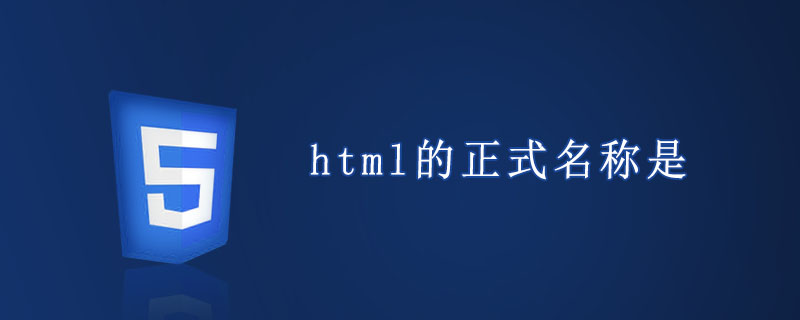The official name of html is
The official name of HTML is "Hypertext Markup Language".
HTML stands for Hyper Text Markup Language. Hypertext language is the universal language of the Internet, a simple and universal all-in-one markup language. It allows web page producers to create complex pages that combine text and images, and these pages can be viewed by anyone else on the Internet, regardless of the type of computer or browser used.

HTML is not a programming language, but a markup language, which is necessary for web page production. "Hypertext" means that the page can contain pictures, links, and even non-text elements such as music and programs.
The structure of hypertext markup language includes a "head" part and a "body" part. The "head" part provides information about the web page, and the "body" part provides the specific content of the web page.
Main features of HTML
1. Simplicity: Hypertext Markup Language version upgrade adopts superset method, making it more flexible and convenient.
2. Scalability: The wide application of hypertext markup language has brought about requirements for enhanced functions and added identifiers. Hypertext markup language adopts the method of subclass elements to ensure system expansion.
3. Platform independence: Although personal computers are popular, there are many people using other machines such as MAC. Hypertext Markup Language can be used on a wide range of platforms. This is another reason why the World Wide Web (WWW) is popular. reason.
4. Universality: HTML is the universal language of the Internet, a simple and universal all-purpose markup language.
2. Requirements for editing HTML files
1. The file extension of the text markup language source program uses htm or html by default to facilitate identification by the operating system or program. , except for custom Chinese character extensions. The extensions of commonly used image files are gif and jpg.
2. The source program of Hypertext Markup Language is a text file, and its column width is not limited, that is, multiple tags can be written in one line, or even the entire file can be written in one line; if written in multiple lines, the browser generally ignores the file The carriage return character in the file (except for mark specification); spaces in the file are usually not displayed according to the effect in the source program.
3. The tag elements in the tag are enclosed in angle brackets. The element with a slash indicates the end of the tag description; most tags must be used in pairs to indicate the start and end of the function; tag Elements ignore case, i.e. they have the same effect.
4. Marking symbols, including angle brackets, mark elements, attribute items, etc., must use half-width Western characters instead of full-width characters.
5. HTML comments start with "", such as . Annotation content can be inserted anywhere in the text. Any mark with an exclamation point inserted at the beginning is marked as a comment and will not be displayed.
The above is the detailed content of The official name of html is. For more information, please follow other related articles on the PHP Chinese website!

Hot AI Tools

Undresser.AI Undress
AI-powered app for creating realistic nude photos

AI Clothes Remover
Online AI tool for removing clothes from photos.

Undress AI Tool
Undress images for free

Clothoff.io
AI clothes remover

Video Face Swap
Swap faces in any video effortlessly with our completely free AI face swap tool!

Hot Article

Hot Tools

Notepad++7.3.1
Easy-to-use and free code editor

SublimeText3 Chinese version
Chinese version, very easy to use

Zend Studio 13.0.1
Powerful PHP integrated development environment

Dreamweaver CS6
Visual web development tools

SublimeText3 Mac version
God-level code editing software (SublimeText3)

Hot Topics
 1664
1664
 14
14
 1422
1422
 52
52
 1316
1316
 25
25
 1267
1267
 29
29
 1239
1239
 24
24
 Table Border in HTML
Sep 04, 2024 pm 04:49 PM
Table Border in HTML
Sep 04, 2024 pm 04:49 PM
Guide to Table Border in HTML. Here we discuss multiple ways for defining table-border with examples of the Table Border in HTML.
 Nested Table in HTML
Sep 04, 2024 pm 04:49 PM
Nested Table in HTML
Sep 04, 2024 pm 04:49 PM
This is a guide to Nested Table in HTML. Here we discuss how to create a table within the table along with the respective examples.
 HTML margin-left
Sep 04, 2024 pm 04:48 PM
HTML margin-left
Sep 04, 2024 pm 04:48 PM
Guide to HTML margin-left. Here we discuss a brief overview on HTML margin-left and its Examples along with its Code Implementation.
 HTML Table Layout
Sep 04, 2024 pm 04:54 PM
HTML Table Layout
Sep 04, 2024 pm 04:54 PM
Guide to HTML Table Layout. Here we discuss the Values of HTML Table Layout along with the examples and outputs n detail.
 HTML Input Placeholder
Sep 04, 2024 pm 04:54 PM
HTML Input Placeholder
Sep 04, 2024 pm 04:54 PM
Guide to HTML Input Placeholder. Here we discuss the Examples of HTML Input Placeholder along with the codes and outputs.
 How do you parse and process HTML/XML in PHP?
Feb 07, 2025 am 11:57 AM
How do you parse and process HTML/XML in PHP?
Feb 07, 2025 am 11:57 AM
This tutorial demonstrates how to efficiently process XML documents using PHP. XML (eXtensible Markup Language) is a versatile text-based markup language designed for both human readability and machine parsing. It's commonly used for data storage an
 HTML Ordered List
Sep 04, 2024 pm 04:43 PM
HTML Ordered List
Sep 04, 2024 pm 04:43 PM
Guide to the HTML Ordered List. Here we also discuss introduction of HTML Ordered list and types along with their example respectively
 HTML onclick Button
Sep 04, 2024 pm 04:49 PM
HTML onclick Button
Sep 04, 2024 pm 04:49 PM
Guide to HTML onclick Button. Here we discuss their introduction, working, examples and onclick Event in various events respectively.




